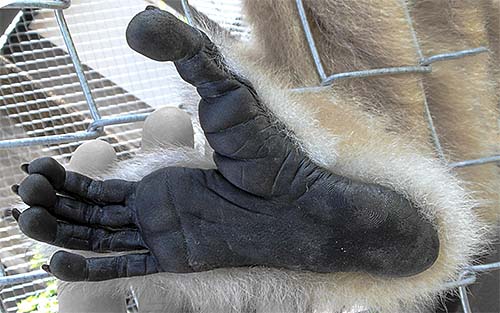Gibbons in Southeast Asia
The gibbon family of the lesser apes inhabited once whole Southeast Asia northwest of the Wallace Line except the Philippines, until deep into China and India. They split into four genera and, according to different sources, into fourteen, eighteen or twenty different species.

Face of a lar gibbon. Image by Asienreisender, Trang / south Thailand, 7/2009
Gibbons live in the tropical and subtropical rainforests. They are dayactive (diurnal) and spend most of their time in the trees, a habitat to which they are perfectly adapted. With their long arms they can swing through the branches and overcome distances of three or more meters. When walking on the ground they do it on their two hind legs while using their arms to keep in balance. Gibbons, like all apes, have no tail.
These apes reach a length without legs of 45cm to 90cm and a weight between 4kg to 13kg. Their colour varies between black and white in different shades.
These apes live monogamous in a certain territory which they defend. A territory measures between 25ha and 50ha. There are seldom violent conflicts with intruders. The usual way of defending is of a more symbolical nature like crying, jumping and breaking branches to impress and fend away the other side. Generally, the gibbons have a rich variety of sounds they produce, and their voices are very strong, much stronger than that of humans, even than that of opera singers. It was sometimes impressing to listen to gibbon sounds in the outskirts of Vang Vieng / Laos, where the apes live in the nearby steep limestone mountains.

The gibbons hands and feet are perfectly adapted to grip firmly around branches. Image by Asienreisender, Si Phan Don (4000 Islands), south Laos, 4/2013
Most of the apes diet consists of fruits, together with leaves. Other animals make only a very small percentage of their food, and that would be mostly insects.
The reproduction rate of the intelligend animals is quite low. Every two to three years a female get's a single cub. When small, the babies cling to their mums; later, the male helps growing up the kid. Maturity is reached in the age between eight and nine years. Life expectancy in the wild is around 25 years. Gibbons don't build nests.
There are examples of hybrides between different gibbon species; there is no proof of fertility of these hybrides, though.
Due to habitat loss and poaching (also gibbons fall in the cruel hocus pocus pattern of Chinese 'medicine'), the apes are everywhere threatend to critically endangered. In the coming years they will widely extinct except maybe in captivity.

Pileated gibbons in Teuk Chhou Zoo, Kampot, Cambodia. They show a sexual dimorphism in their colours. The bright, left one is female, the right one male. Images and photocomposition by Asienreisender, 9/2014, 2017

In a remote place in the forests around Ranong's hot springs I found this poor animal. Kept isolated in a filthy cage, I don't think it's good for the intelligent ape to live under so deprived circumstances. Spending some time there repeatedly, I guess it would be easy to make a good relationship with him. Around were some Thai policemen. I am very afraid, that the monkey was going to be sold to wealthy people who think eating it would be a good thing for them... Images and photocomposition by Asienreisender, 8/2012, 2017
Sources
This article has been triggered by seeing gibbons in different parts of Southeast Asia. Moreover it's based on a number of publications, namely 'Mammals of Thailand' and 'Grzimek's Animal Life Encyclopedia'. An internet research helped me to specify different kinds of the nice animals.